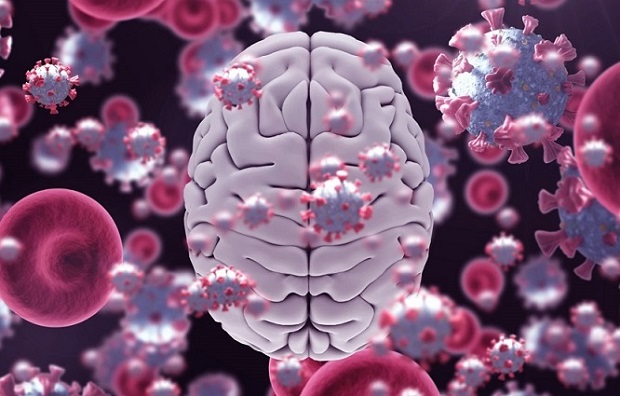Nikhil Prasad Fact checked by:Thailand Medical News Team Sep 07, 2025 4 months, 1 day, 5 hours, 29 minutes ago
Medical News: A new look at how the SARS-CoV-2 virus damages the brain
Researchers East Carolina University’s Brody School of Medicine and the NC State University’s College of Veterinary Medicine have made a breakthrough in understanding how COVID-19 can damage the brain. Their work sheds light on a critical brain region known as the substantia nigra pars compacta, which plays a key role in controlling movement and is often affected in Parkinson’s disease.
 COVID-19 Virus Found to Trigger Brain Inflammation Pathway
COVID-19 Virus Found to Trigger Brain Inflammation Pathway
This
Medical News report reveals how SARS-CoV-2, the virus responsible for COVID-19, disrupts the balance of brain chemistry by lowering levels of a small molecule called microRNA-330-5p. These molecules normally regulate how genes behave. When their levels fall, it triggers an increase in a gene known as ADAM17, which fuels damaging inflammation. This may explain why some patients suffer lingering brain-related symptoms long after their initial infection has cleared.
How the experiments were conducted
The scientists used genetically engineered mice carrying the human ACE2 receptor, which the coronavirus exploits to infect cells. These mice were given a low dose of the virus through the nose to simulate natural infection. Ten days later, their brains were examined. Interestingly, only two out of seven infected mice showed clear viral invasion of the substantia nigra pars compacta, but in those cases the changes were dramatic.
The infected brain regions displayed higher levels of inflammatory markers, such as interleukin-1β and the kinin B1 receptor. At the same time, microglia, the brain’s frontline immune cells that protect neurons, were reduced. Most importantly, the study found that levels of microRNA-330-5p dropped significantly, while ADAM17 activity surged. This imbalance created an environment primed for inflammation and potential nerve cell injury.
Why this finding matters
The substantia nigra pars compacta contains dopamine-producing neurons that control smooth movement. Loss of these neurons causes the tremors and stiffness seen in Parkinson’s disease. The new study suggests that SARS-CoV-2 may trigger a similar destructive process by disrupting microRNA regulation and pushing the brain toward inflammation.
Laboratory tests confirmed that microRNA-330-5p normally keeps ADAM17 activity under control. When the virus suppressed this microRNA, ADAM17 became hyperactive, driving inflammatory responses that could harm brain tissue. This mechanism could explain why some COVID-19 survivors develop persistent neurological symptoms, while others recover without brain involvement. Just as in humans, only a subset of the mice developed midbrain infection and inflammation.
Broader implications for long COVID
The discovery adds to a growing body of research showing that COVID-19 is not only a respiratory illness but also a disease capable of invading the central nervous system. While much research has focused o
n the forebrain and hindbrain, this study provides rare insights into the midbrain, a region central to both movement and behavior.
The findings also point to the possibility of new treatments. Since microRNAs are already being studied as drug targets in cancer and heart disease, therapies that restore microRNA-330-5p balance might one day help protect the brain from long COVID complications. The researchers also note that further studies are needed to explore why only certain brains are affected and how long these molecular disruptions persist.
Conclusion
This study is the first to show that SARS-CoV-2 can directly enter the substantia nigra pars compacta and alter microRNA regulation in ways that fuel brain inflammation. By lowering microRNA-330-5p and allowing ADAM17 to surge, the virus may accelerate the loss of dopamine neurons and raise the risk of long-term neurological disorders such as Parkinson’s disease. Importantly, not every infected brain is affected, mirroring the variability seen in human patients. These findings highlight how COVID-19 may contribute to brain fog, headaches, movement problems, and other long-lasting symptoms. They also suggest that microRNA-based therapies could become a valuable tool in protecting survivors from serious brain damage. As scientists continue to study these pathways, the hope is that more effective treatments will emerge to address the long-term consequences of COVID-19.
The study findings were published in the peer reviewed Journal of General Virology.
https://www.microbiologyresearch.org/content/journal/jgv/10.1099/jgv.0.002149
For the latest COVID-19 News, keep on logging to Thailand
Medical News.
Read Also:
https://www.thailandmedical.news/news/covid-19-loss-of-smell-and-brain-inflammation-can-be-reversed-with-plant-compound
https://www.thailandmedical.news/news/scientists-raise-alarms-after-discovering-that-covid-19-can-cause-cytotoxic-brain-lesions-in-the-corpus-callosum
https://www.thailandmedical.news/news/neuroinflammation-in-the-brainstem-and-its-link-to-pots-and-long-covid
